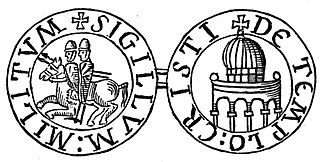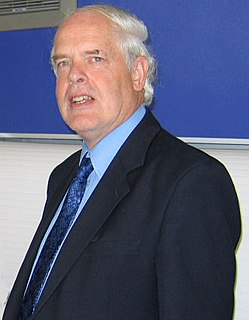
The Poor Fellow-Soldiers of Christ and of the Temple of Solomon, also known as the Order of Solomon's Temple, the Knights Templar, or simply the Templars, was a Catholic military order, one of the most wealthy and popular of the Western Christian military orders. They were founded in 1119, headquartered on the Temple Mount in Jerusalem, and existed for nearly two centuries during the Middle Ages.

The Taxil hoax was an 1890s hoax of exposure by Léo Taxil intended to mock not only Freemasonry but also the Catholic Church's opposition to it.
The York Rite, sometimes referred to as the American Rite, is one of several Rites of Freemasonry. It is named for, but not practiced in York, Yorkshire, England. A Rite is a series of progressive degrees that are conferred by various Masonic organizations or bodies, each of which operates under the control of its own central authority. The York Rite specifically is a collection of separate Masonic Bodies and associated Degrees that would otherwise operate independently. The three primary bodies in the York Rite are the Chapter of Royal Arch Masons, Council of Royal & Select Masters or Council of Cryptic Masons, and the Commandery of Knights Templar, each of which are governed independently but are all considered to be a part of the York Rite. There are also other organizations that are considered to be directly associated with the York Rite, or require York Rite membership to join such as the York Rite Sovereign College but in general the York Rite is considered to be made up of the aforementioned three. The Rite's name is derived from the city of York, where, according to one Masonic legend, the first meetings of Masons in England took place.

Jacques de Molay, also spelled "Molai", was the 23rd and last grand master of the Knights Templar, leading the order from 20 April 1292 until it was dissolved by order of Pope Clement V in 1312. Though little is known of his actual life and deeds except for his last years as Grand Master, he is one of the best known Templars.

Baphomet is a deity allegedly worshipped by the Knights Templar that subsequently became incorporated into various occult and Western esoteric traditions. The name Baphomet appeared in trial transcripts for the Inquisition of the Knights Templar starting in 1307. It first came into popular English usage in the 19th century during debate and speculation on the reasons for the suppression of the Templar order. Baphomet is a symbol of balance in various occult and mystical traditions, the origin of which some occultists have attempted to link with the Gnostics and Templars, although occasionally purported to be a deity or a demon. Since 1856 the name Baphomet has been associated with the "Sabbatic Goat" image drawn by Éliphas Lévi, composed of binary elements representing the "symbolization of the equilibrium of opposites": half-human and half-animal, male and female, good and evil, etc. Lévi's intention was to symbolize his concept of balance, with Baphomet representing the goal of perfect social order.

Henry I Sinclair, Earl of Orkney, Lord of Roslin was a Scottish and a Norwegian nobleman. Sinclair held the title Earl of Orkney and was Lord High Admiral of Scotland under the King of Scotland. He was sometimes identified by another spelling of his surname, St. Clair. He was the grandfather of William Sinclair, 1st Earl of Caithness, the builder of Rosslyn Chapel. He was best known today because of a modern legend that he took part in explorations of Greenland and North America almost 100 years before Christopher Columbus. William Thomson, in his book The New History of Orkney, wrote: "It has been Earl Henry's singular fate to enjoy an ever-expanding posthumous reputation which has very little to do with anything he achieved in his lifetime."

Rosslyn Chapel, formerly known as the Collegiate Chapel of St Matthew, is a 15th-century chapel located in the village of Roslin, Midlothian, Scotland.
Hundreds of conspiracy theories about Freemasonry have been described since the late 18th century. Usually, these theories fall into three distinct categories: political, religious, and cultural. Many conspiracy theories have connected the Freemasons with worship of the devil; these ideas are based on different interpretations of the doctrines of those organizations.

Robert Lomas is a British writer, physicist and business studies academic. He writes primarily about the history of Freemasonry as well as the Neolithic period, ancient engineering, and archaeoastronomy.
The Hiram Key: Pharaohs, Freemasonry, and the Discovery of the Secret Scrolls of Jesus, is a 1996 book by Christopher Knight and Robert Lomas. The authors, both Freemasons, present a theory of the origins of Freemasonry as part of their "true story" of the historical Jesus and the original Jerusalem Church.

The Poor Fellow-Soldiers of Christ and the Temple of Jerusalem, or Templars, was an Order product of the crusades founded in 1119.

The Knights Templar, full name The United Religious, Military and Masonic Orders of the Temple and of St John of Jerusalem, Palestine, Rhodes and Malta, is a fraternal order affiliated with Freemasonry. Unlike the initial degrees conferred in a regular Masonic Lodge, which only require a belief in a Supreme Being regardless of religious affiliation, the Knights Templar is one of several additional Masonic Orders in which membership is open only to Freemasons who profess a belief in Christianity. One of the obligations entrants to the order are required to declare is to protect and defend the Christian faith. The word "United" in its full title indicates that more than one historical tradition and more than one actual order are jointly controlled within this system. The individual orders 'united' within this system are principally the Knights of the Temple, the Knights of Malta, the Knights of St Paul, and only within the York Rite, the Knights of the Red Cross.

There are many organisations and orders which form part of the widespread fraternity of Freemasonry, each having its own structure and terminology. Collectively these may be referred to as Masonic bodies, Masonic orders or appendant bodies of Freemasonry.

There are Masonic degrees named after the Knights Templar but not all Knights Templar Orders are Masonic.
Germany and Austria have spawned many movements and practices in Western Esotericism, including Rosicrucianism, theosophy, anthroposophy and ariosophy, among others.
The original historic Knights Templar were a Christian military order, the Order of the Poor Fellow Soldiers of Christ and of the Temple of Solomon, that existed from the 12th to 14th centuries to provide warriors in the Crusades. These men were famous in the high and late Middle Ages, but the Order was disbanded very suddenly by King Philip IV of France, who took action against the Templars in order to avoid repaying his own financial debts. He accused them of heresy, ordered the arrest of all Templars within his realm, put the Order under trial and many of them burned at the stake. The dramatic and rapid end of the Order led to many stories and legends developing about them over the following centuries. The Order and its members increasingly appear in modern fiction, though most of these references portray the medieval organization inaccurately.
John J. Robinson was an American author, best known as the author of Born in Blood: The Lost Secrets of Freemasonry. He is also credited as being the "founding visionary" of the Masonic Information Center run by the Masonic Service Association of North America. He was a member of the Medieval Academy of America, the Organization of American Historians, and the Royal Over-Seas League of London.

Thomas Dunckerley was a prominent freemason, being appointed Provincial Grand Master of several provinces, promoting Royal Arch masonry, introducing Mark Masonry to England, and instituting a national body for Templar masonry. This was made possible by an annuity of £100, rising to £800, which he obtained from King George III by claiming to be his father's illegitimate half brother.

The Larmenius Charter or Carta Transmissionis is a coded Latin manuscript purportedly created by Johannes Marcus Larmenius in February 1324, detailing the transfer of leadership of the Knights Templar to Larmenius after the death of Jacques de Molay. It also has appended to it a list of 22 successive Grand Masters of the Knights Templar after de Molay, ending in 1804, the name of Bernard-Raymond Fabré-Palaprat appearing last on the list. The document is written in a supposed devised ancient Knights Templar Codex. Actually in Freemason custody, the document is kept at the Mark Masons Hall in London. Some researchers have concluded that it is a forgery, while others assert its authenticity.

Karl Gotthelf, Baron von Hund und Altengrotkau was a German freemason. In 1751, he founded the Rite of Strict Observance.














